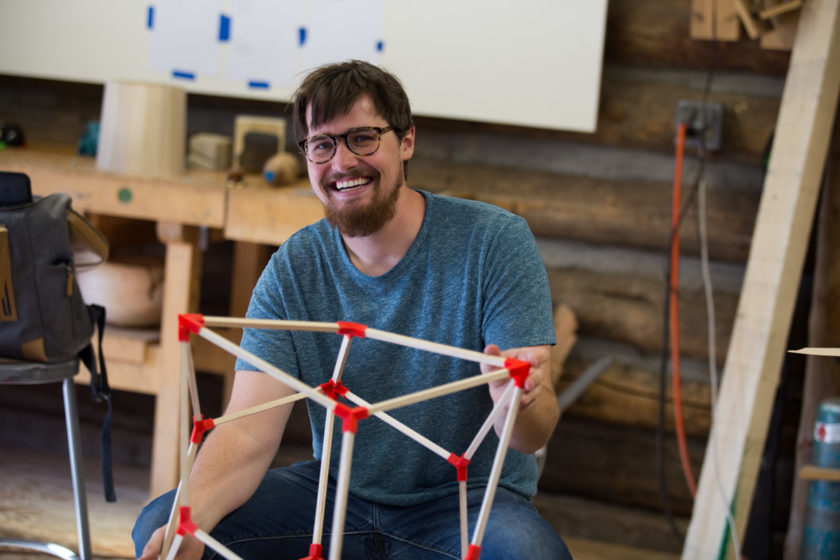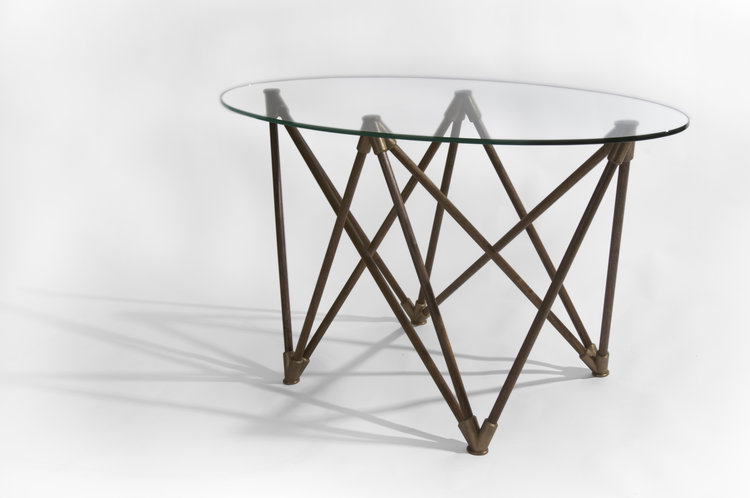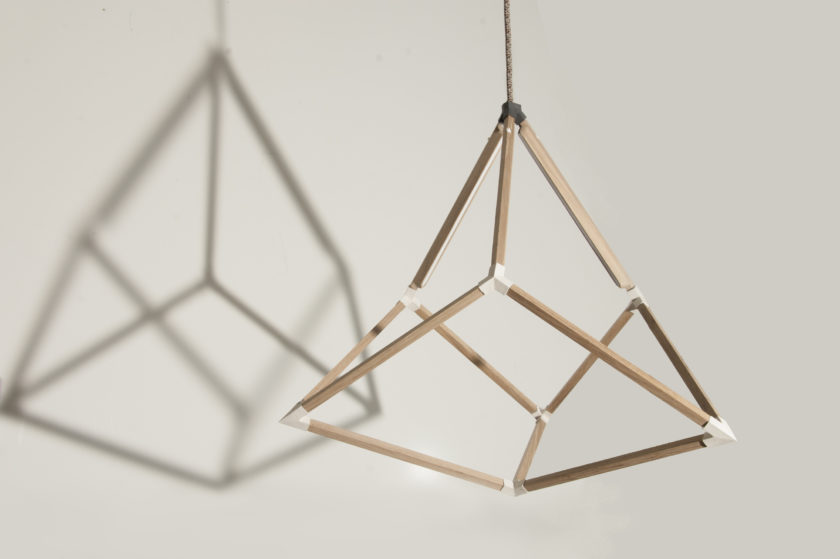Furniture designer Colin Wiencek’s early explorations of 3D printing led to his Trico Table, an elegant combination of wood, tempered glass, and 3D printed bronze connectors. Here, Colin talks about the role 3D printing plays in his design and production processes, and his dream of making fully 3D printed furniture.
What made you want to become a furniture designer?
When I went to college I was initially set to study photography, but in my freshman year I had the chance to take several classes that exposed me to working in three dimensions. I loved the idea that something that I made could have a functional life. I loved being in the shop with the dust, noise, and grease. I loved taking a sketch on paper and bringing it into the real world.
Seven years later, I have never looked back.
“I loved the idea that something that I made could have a functional life. I loved being in the shop with the dust, noise, and grease. I loved taking a sketch on paper and bringing it into the real world.”
Where did you first get exposed to 3D printing?
When I was at the Rhode Island School of Design, 3D printers were just starting to become available and you had to seek them out. The first project I attempted was building a chair out of 30 interconnecting prints. And this was on an early MakerBot that was quite prone to warping. It came out a huge mess, but it worked!
There’s a picture of you with wood and plastic connectors. Is that an early iteration of your furniture?
Yes. I first made form studies using PLA prints from da Vinci and Monoprice 3D printers, then moved to prototypes using Shapeways Strong and Flexible Plastic. Then I attempted to make ceramic slip cast connectors, by making a mold from solid prints done in Strong and Flexible. This resulted in a beautiful connection that was just too fragile to be viable.
After this I explored CNC milling, investment casting, and bronze impregnated PLA, but I ended up finding that at the small volume that I am at today, Shapeways 3D Printed Steel was the most cost-effective solution compared with the labor involved in cleaning up other processes.
3D printing also allows for affordable customization. There is no tooling cost that would make custom parts too expensive.
You spent a winter as Furniture Design and Woodworking Resident at the Anderson Ranch Arts Center. How did that lead to the Trico Collection?
Anderson Ranch provided studio space, accommodations, and the freedom to explore whatever projects interested me for three months. Nowhere else, even in college, have I felt as free to explore exactly what I wanted to without outside financial or course-credit concerns. This freedom was coupled with a creative community that provided instant feedback to even my most crazy ideas.
“Anderson Ranch provided studio space, accommodations, and the freedom to explore whatever projects interested me for three months. Nowhere else, even in college, have I felt as free to explore exactly what I wanted to without outside financial or course-credit concerns.”
At the Ranch I took this idea of modular construction from an idea on paper through form studies to a working prototype with ceramic hubs. I determined it was worth extra exploration, and this led to many months of continued development after the residency.
Tell us about your design process and where Shapeways fits into it.
For every decision, I create full scale models with small differences so that I can evaluate how each decision looks in real space. I test every dimension and material at full scale before I produce a final design. This can be quite time consuming, but it results in better design.
3D printing has been a huge help in this as it allows me to speed up my workflow. The printer is always working, whether I am at the desk or not. I have a few small and cheap FDM printers in my studio that do the bulk of the prototyping work. Nothing can beat the speed on having your own printer.
But when I need to create presentation models for clients or for early stage photography and marketing images, I turn to Shapeways. In particular I have used the Strong and Flexible Plastic as it is strong enough to stand up to the torsion in geometric structures and looks great on camera.
“After prototyping I also turn to Shapeways for final production prints. As mentioned above, 3D printed steel blows other production methods out of the water in terms of price and speed.”
After prototyping I also turn to Shapeways for final production prints. As mentioned above, 3D printed steel blows other production methods out of the water in terms of price and speed.
Do your customers understand that your work involves 3D printed pieces? Do they care?
Running a small studio, I pride myself on intense client focus and the ability to customize is important to many of my clients.
This, more than the printing process itself, is what my clients appreciate. They like that they can ask for small changes without the cost jumping up 10,000%.
Some interior designers appreciate the “cool” factor of the 3D printing process, but I am not sure that in itself translates to more sales, because in the end most designers are buying based on aesthetic and quality.
“…I pride myself on intense client focus and the ability to customize is important to many of my clients. This, more than the printing process itself, is what my clients appreciate. They like that they can ask for small changes without the cost jumping up 10,000%.”
What for you is the relationship between handicraft and digital fabrication?
Both have their strengths and weaknesses, and are tools to be used when appropriate.
Digital fabrication provides accuracy and repeatability, but can be time-consuming, especially when modeling small details.
Handcraft can create tiny details that, while being less accurate, are beautiful in their imperfection. Natural materials have much more warmth than 3D printing materials.
How would you be making furniture if 3D printing wasn’t an option for you?
I have spent most of my education and career not using 3D printing in my work so my ability to create wouldn’t be changed — but what I create would change dramatically. The complexity of my designs would be reduced. Highly geometric work would be less practical to produce.
“Don’t be confined by traditional aesthetics or production methods. If you have an idea and you think it might work, try it. Build it at full scale, and, even if it collapses, your next iteration will be better.”
You’ve also made a couple of geometrical solid necklaces. Do you do much jewelry design, or was that more research?
Those were both early form studies for the Trico Collection that by happenstance made for great pendants. I hope to expand more into other types of objects, but today the focus is on lighting and furniture.
Right now you make large pieces of furniture with small 3D printed parts. Do you hope to make entirely 3D printed furniture one day?
I would love to get my hands on a printer large and cost-effective enough to print full pieces of furniture. I recently saw a makerspace in Baltimore called Open Works that has a 4’x4’x4’ printer with a large nozzle to print thick PLA layers. This really excited me! The bed is the perfect size to print a chair and I would love to see what crazy designs could be achieved on such a printer.
What advice would you give someone to wants to start making furniture?
Don’t be confined by traditional aesthetics or production methods. If you have an idea and you think it might work, try it. Build it at full scale, and, even if it collapses, your next iteration will be better.
To learn more about Colin’s furniture, lighting, and jewelry designs, visit the C.Wiencek website, or follow him on Instagram or Pinterest. You can also hire him as a designer through Shapeways.





